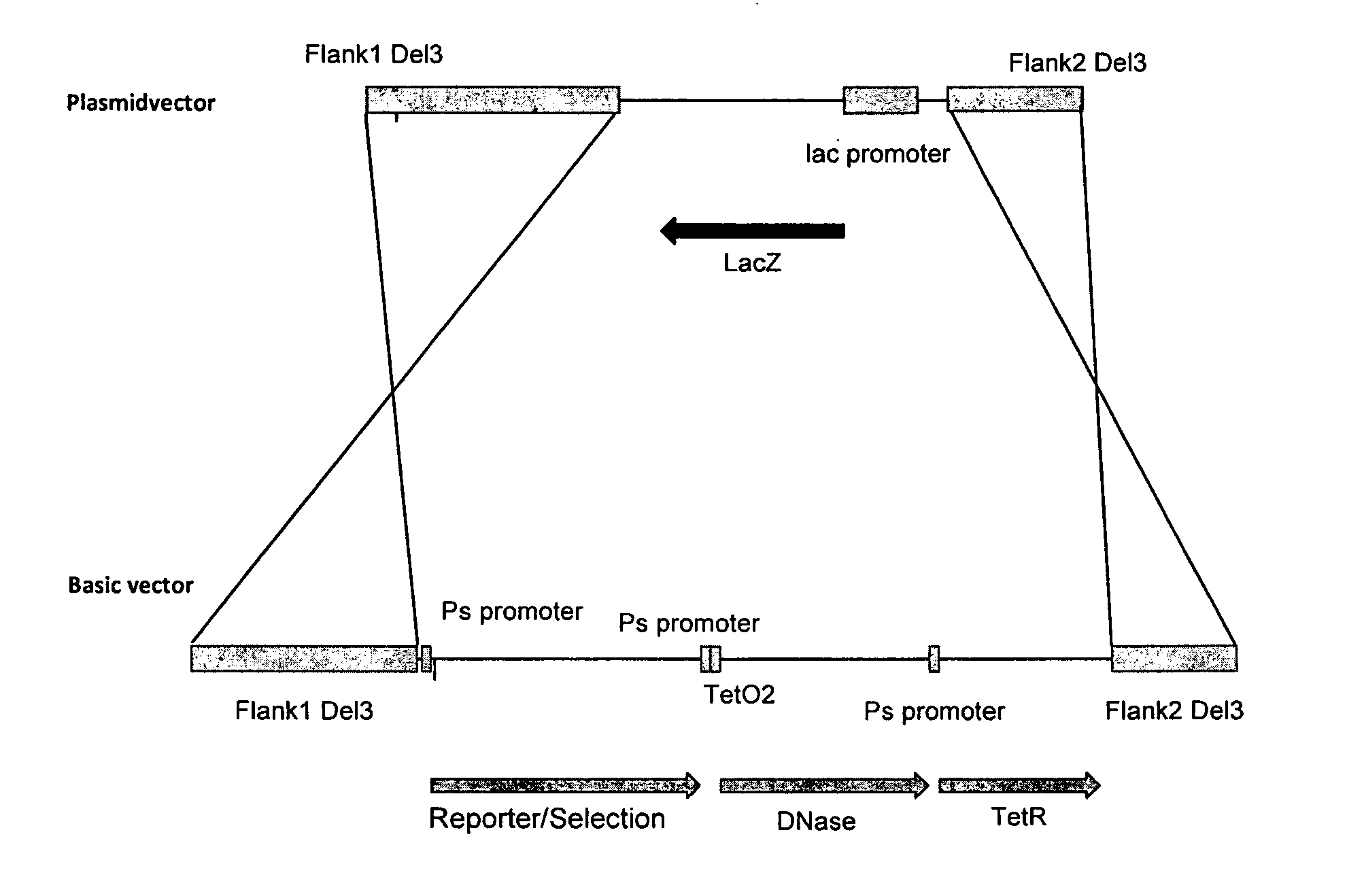Single Recombination System and Methods of Use
- Summary
- Abstract
- Description
- Claims
- Application Information
AI Technical Summary
Benefits of technology
Problems solved by technology
Method used
Image
Examples
example 1
Cloning of the Modified MVA Vector Selection Component
[0071]The reporter gene / selection component cassette was inserted into the MVA genome by homologous recombination. For this purpose, the single components of (i) reporter gene, (ii) Ps-TetO2-DNAse, and (iii) TetR were cloned in a stepwise fashion into a bacterial plasmid.
[0072]Cloning of the DNAse Gene
[0073]The DNase fragment (SpeI-Ps-TetO2-DNAse-SacI) was synthesized via a two-step PCR process and cloned in the vector vEM11 (SpeI / SacI) (SEQ ID NO: 15), resulting in the production of vEM12 (SEQ ID NO: 16).
[0074]For the first PCR step, the following oligonucleotides were used:
1) oEM167:(SEQ ID NO: 8)TetO2-DNAse start; TCCCTATCAGTGATAGAGATCTCCCTATCAGTGATAGAGATATGAGGGGCATGAAGCTGCTG2) oEM168:(SEQ ID NO: 9)DNase end-SacI; GAGCTCCTACTTCAGCATCACC
[0075]The template for this PCR process was the plasmid pENTR-DNAse (Invitrogen ORF Clone collection, clone ID IOH23149) that contained a human DNase open reading frame. This first PCR step resu...
example 2
Cloning of the Modified MVA Vector
[0088]vEM31, 32 and 33 were each employed to create modified MVA vectors. For this purpose, CEF cells were infected with MVA (moi 0.05) and then transfected with vEM31, 32 or 33, individually. The MVA particles released by the infected CEF cells were then passaged three times using fresh CEF cells and under selective conditions (e.g. blasticidine containing medium; 5 μg / ml), since cells containing recombinant MVA (i.e., the modified MVA vectors) are resistant to this antibiotic. The recombinant MVA particles were subsequently purified by plaque purification and using a FACS unit (fluorescence activated cell sorter).
[0089]Following amplification and characterization of the resulting modified MVA vectors resulting from recombination of MVA with vEM31 (mEM06, Ps-TetR), with vEM32 (mEM07, 7.5-TetR) and with vEM33 (mEM08, H5-TetR), the tetracycline / DNase system was used for testing.
example 3
Assessment of the Tetracycline / DNAse System
[0090]For testing the inducible reverse selection system, cells were infected with modified MVA viruses mEM06, 07 and 08 individually and incubated in tetracycline-containing medium. Different concentrations of tetracycline were used for analysis (0-500 μg / ml).
[0091]In order to assess the influence of the inducible DNAse expression on the replication of unmodified MVA, MVA-infected cells were transfected with (vEM12) to facilitate the transient expression of DNAse. Furthermore, the influence of tetracycline on the replication of unmodified MVA was analyzed by incubating MVA-infected cells with tetracycline only. Additionally, for monitoring the influence of tetracycline on the growth and status of cells, MVA infected and uninfected CEF cells were incubated with the identical tetracycline concentrations used for testing of the modified virus vectors.
[0092]Briefly, CEF cells were infected with the modified MVA viruses mEM07 (7.5=7.5 promoter)...
PUM
| Property | Measurement | Unit |
|---|---|---|
| Fraction | aaaaa | aaaaa |
| Length | aaaaa | aaaaa |
| Fluorescence | aaaaa | aaaaa |
Abstract
Description
Claims
Application Information
 Login to View More
Login to View More - R&D
- Intellectual Property
- Life Sciences
- Materials
- Tech Scout
- Unparalleled Data Quality
- Higher Quality Content
- 60% Fewer Hallucinations
Browse by: Latest US Patents, China's latest patents, Technical Efficacy Thesaurus, Application Domain, Technology Topic, Popular Technical Reports.
© 2025 PatSnap. All rights reserved.Legal|Privacy policy|Modern Slavery Act Transparency Statement|Sitemap|About US| Contact US: help@patsnap.com



